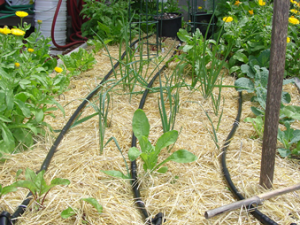|

Watering techniques and conservation measures for your home
vegetable garden
By Deborah Cavanaugh-Grant,
local food systems and small farms educator,
University of Illinois
Extension
|
The well was dry beside
the door,
And so we went with pail
and can
Across the fields behind
the house
To seek the brook if still
it ran.
--From the poem "Going for Water" by Robert Frost |
 Send a link to a friend
Send a link to a friend
[July 14, 2012]
As you are all aware, our brooks are
not running. You also know that in your vegetable garden there is a
direct correlation between an adequate water supply and the quality
and yield of your harvest. As it doesn't seem likely that we will
have a reprieve from the drought anytime soon, I wanted to share
some tips for watering your garden, as well as water-saving
conservation measures.
|
 Vegetables need about 1 inch of water per week, which is
equivalent to about 63 gallons of water per 100 square feet per
week during the growing season. With concerns about water
conservation, it is critical that any method you choose to use
applies water around the root zone of the plant. This method
will result in reducing water usage by about 50 percent. Vegetables need about 1 inch of water per week, which is
equivalent to about 63 gallons of water per 100 square feet per
week during the growing season. With concerns about water
conservation, it is critical that any method you choose to use
applies water around the root zone of the plant. This method
will result in reducing water usage by about 50 percent.
Several types of drip or trickle equipment are available. The
soaker hose is probably the easiest to use, as it requires no
installation. A soaker hose is a fibrous hose that allows water
to slowly seep out all along its length. It is simply laid at
the base of the plants and moved around the garden as needed.
There are also complete kits containing attachments and PVC hose
with holes to allow gradual water release. Lastly, there is the
emitter-type system in which short tubes, or emitters, come off
a main water supply hose and go right to the roots of the
individual plants.

Using a timer with your drip hose can provide additional
water conservation. A timer directs the frequency, time of day
and duration of each application of water to ensure that water
is not wasted. Timers may be simple, requiring the gardener to
set the length of time the water will flow, or more complex
timers can be set to turn the water on and off, based on the
number of hours or days between watering.
Irrigate in the morning when temperatures are cool but
rising. When morning watering is not possible, water your garden
in the late afternoon or very early evening -- after the day's
heat has passed. Water early enough that the leaves will dry
before nighttime.
[to top of second column] |

Mulching minimizes evaporation of water from the soil
surface, reducing irrigation needed by around 50 percent. Use an
organic mulch to a depth of 1-3 inches, depending upon the
particle size of the mulching material (the larger the particle,
the deeper the mulch that should be applied).
According to the University of Illinois publication "Watering
Techniques for Home Vegetable Gardens," most vegetables require
adequate moisture from the time they are seeded or transplanted into
the garden, but there are critical times when they definitely
require water. Here are some of the commonly grown vegetables and
the developmental stages when the need for adequate soil moisture is
most critical:
-
Beans (including
lima and snap) -- pollination, pod development and pod
enlargement
-
Broccoli, cabbage,
cauliflower -- head development
-
Tomato, eggplant,
pepper -- from flowering to harvest
-
Dry onions -- bulb
enlargement
-
Cucumbers,
muskmelons, watermelons -- flowering, fruit development
-
Carrots, radish,
turnips -- root enlargement
-
Potato -- tuber set
and when the tuber is enlarging
-
Sweet corn -- during silking, tasseling
and ear development
[By
DEBORAH CAVANAUGH-GRANT,
University of Illinois Extension]
 |